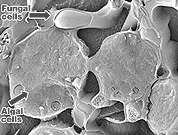In 2005, scientists investigated whether lichen would survive in space.
A main focus for these scientists was to gather in vivo data on whether the harsh conditions of space do or do not necessarily kill life. If it can be shown that organism survive the harsh conditions of space, it provides an argument to the theory of panspermia, which proposes that some life forms on one planet can contaminate another planet, traveling for example on meteor ejecta. [1] [2]
The experiment was conducted under the scientific leadership of Professor Leopoldo Sancho from the Complutense University of Madrid, with Dr. Rosa de la Torre from the Spanish Aerospace Research Establishment (INTA) in Madrid, Spain, Dr. L.G. Sancho of the Universidad Complutense de Madrid in Madrid, Spain, Dr. G Horneck of the Institut für Luft und Raumfahrtmedizin, DLR, Koln, Germany, Dr. C. Ascaso of the Universitat de Lleida in Lleida, Spain and Dr. J. Wierzchos of the CSIC in Madrid, Spain.
The motive for the choice of lichen was that laboratory tests with single prokaryote cell organisms, bacteria, had already shown that they can survive after 6 years exposure to space conditions. Common Earth soil bacteria, Bacillus Subtilis, survived unprotected in space aboard the Long Duration Exposure Facility (LDEF) for 6 years [3]. The scientists wanted to verify whether larger organisms composed of much more than one cell could survive as well.
Lichens are an association of millions of eukaryote cells, algal and fungi, much higher in the evolutionary scale than bacteria, which cooperate in a symbiotic relationship with alga providing food to the fungi via photosynthesis while the fungi provide the alga with a suitable living environment for growth. Scientists also noted that some lichens, that can be found up to high mountain tops on earth, have a mineral coating that apparently shields the organisms from ultraviolet radiations. [7] [9]
All in all, lichens were thus chosen because they are extremophiles that survive the harshest environments on Earth and were thus seen as a promising large life form for a survival test in space; which was already positively verified in vitro in 2004. [10]
The 2005 experience was conducted in vivo in space within the frame of the exobiology works at the European Space Agency during the Foton-M2 mission launched on a Russian Soyuz rocket on May 31, 2005, it was simply called "Lichens" and it resulted in the discovery that lichens are very adept at surviving in open space.
The tested lichens were of two different species, Rhizocarpon geographicum and Xanthoria elegans, and were located in a compartment called Biopan on the outer shell of the Foton return module. When Foton reached its correct orbital altitude, in May 2005, the Biopan compartment was opened and the samples were thus exposed to open space: vacuum, wide fluctuations of temperature, bombardment of the full spectrum of solar light and cosmic radiation. [5]
The lichens were permanently exposed to these conditions for 14.6 days, and then the lid of was closed to protect the lichens from the conditions of reentry. The Biopan compartment was recovered and brought to ESA's research facility ESTEC in Noordwijk, the Netherlands and opened. [4]
The results of the experiment were presented at a post-flight review in October at ESTEC. The initial conclusions of the experiment indicated that the lichens were alive, that having the capacity to resist full exposure to the harsh space conditions, especially high levels of UV radiation. [4]
Post flight analysis then showed that all the lichen had fully survived and that its ability for photosynthesis was not changed at all by the exposure to the conditions of space. [4] [5] [6]
The experiment's team wrote: [8]
|
One of this species was Rhizocarpon geographicum, a bipolar epilithic lichen, which grows at high mountain regions (e.g., Sierra de Gredos, Central Spain) with continental climate, has been systematically studied in the natural environment (Plataforma de Gredos at 2000 m altitude) as well as under simulated space conditions at the space simulation facilities of the DLR. The sensitivity of the photosynthetic system (PSII) to the different environmental conditions (dryness including vacuum treatment, high temperature fluctuations, high UV intensity) was fluorometrically measured with a MINI PAM (Walz, Germany). The lichen Rhizocarpon geographicum was extremely resistant to the harsh natural environment of the high mountains as well as to the simulated space conditions. This results were corroborated by the surprising results after Foton M-2 flight, when lichen samples of Rhizocarpon geographicum and Xanthoria elegans were preactivated at the Eco-Physiology Laboratory of the Universidad Complutense of Madrid, showing a recovery of the photosynthetic activity in 90-100% from the activity registered before flight. Lichens have resist [sic, resisted] in an optimal form to space vacuum, wide fluctuations of temperatures, the complete spectrum of solar UV light and cosmic radiation during 15 days. This experiment add new knowledgment to the Panspermia Theory, supporting the possibility of transfer of life between planets. The follow up experiment Lithopanspermia will answer the question if lichens transported by a meteorite can survive the re-entry conditions into Earth's atmosphere. |
Follow-up ground and flight studies are planned for September 2007, to determine how much longer lichens can survive in space conditions, and whether they could survive atmosphere re-entry effects on board a meteorite. [7]
ESA indicates that the outcome of the "Lichen" experiment also suggests that lichens might survive at the surface of Mars. [4]

|
Here is an electron microscopic photograph of lichen following the Foton-M2 Biopan post-flight analysis. The cells are complete and not broken, and back on earth, the lichen performed fully as if it had not been exposed to space conditions for two weeks. (ESA photograph) |